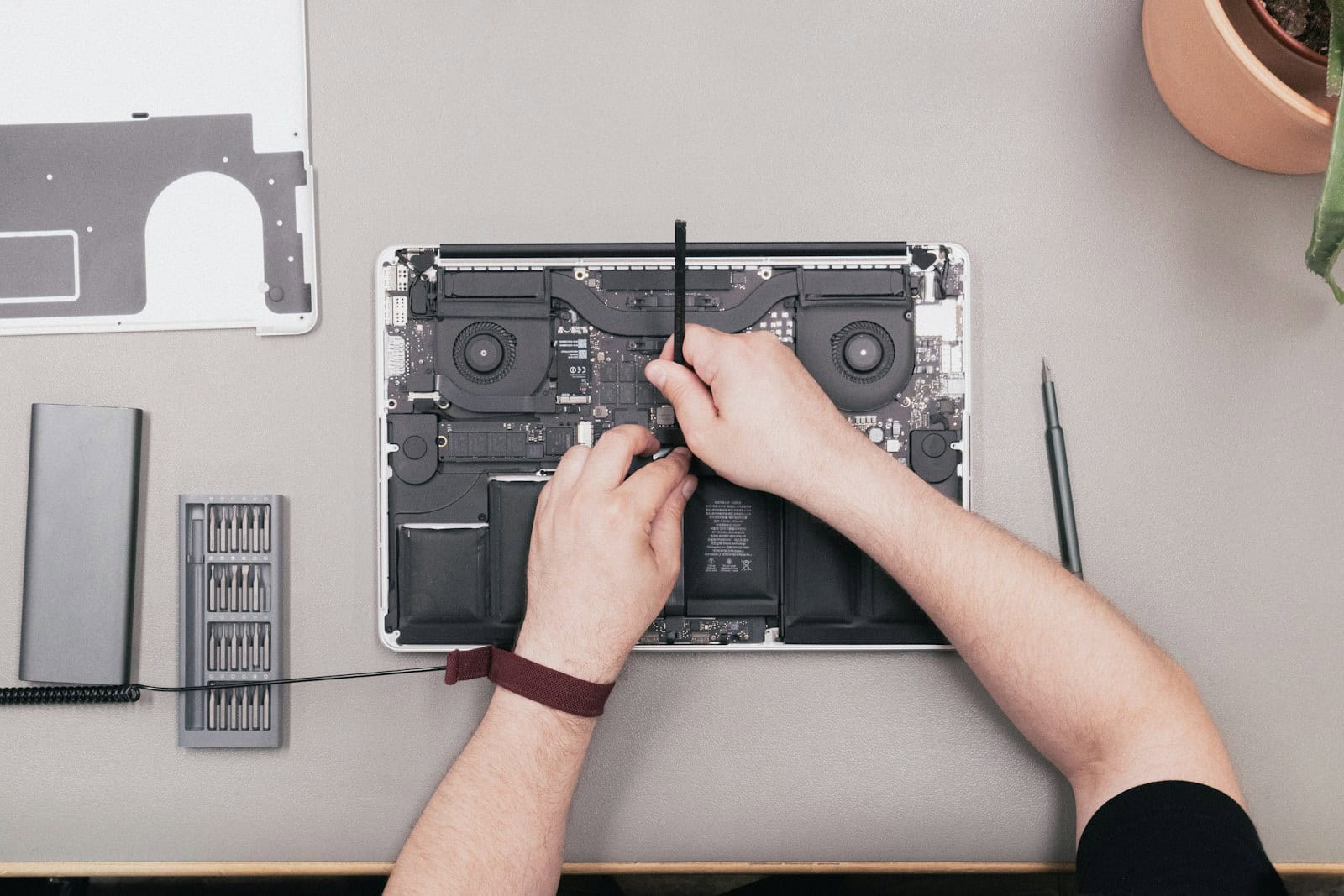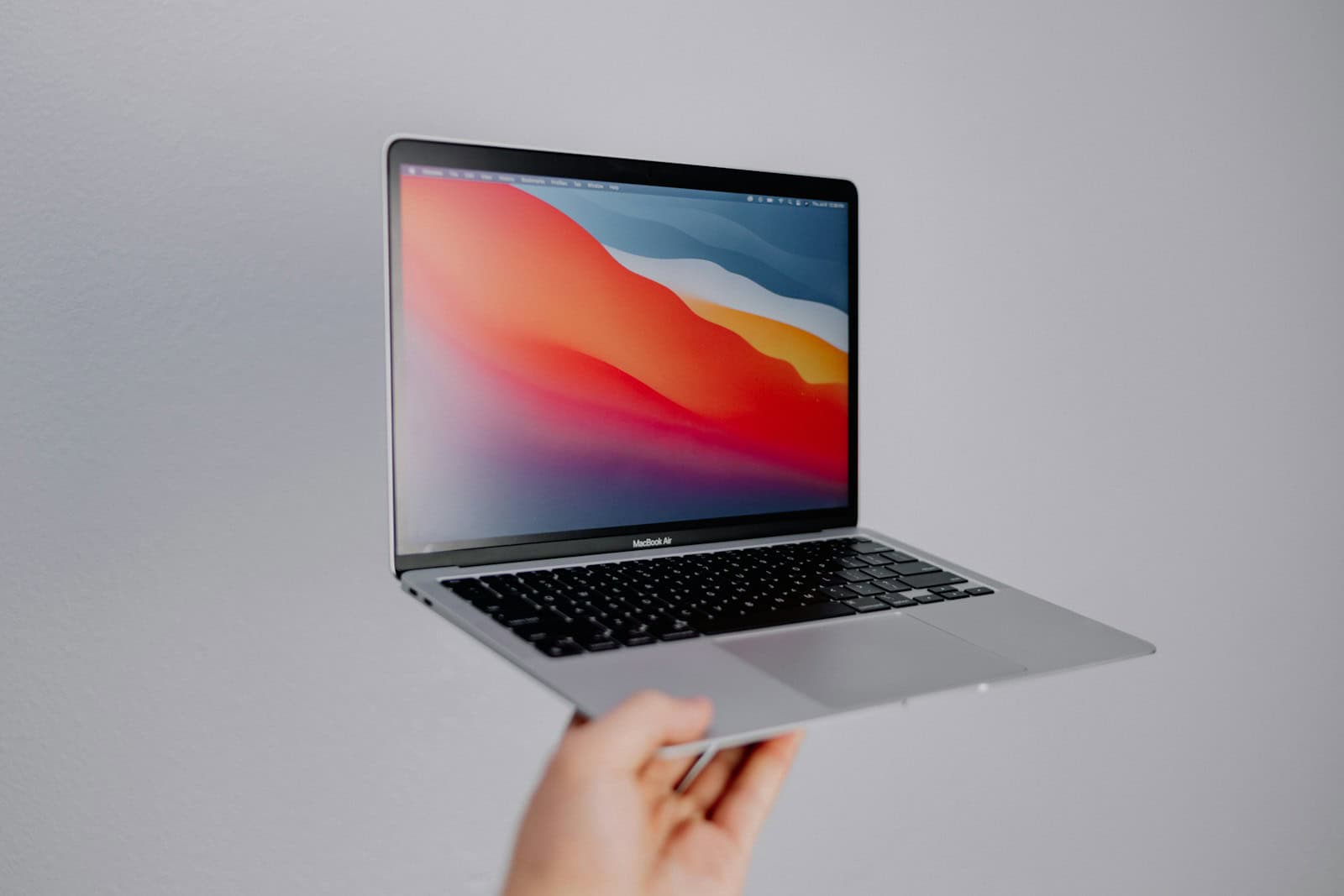MacBook Air laptops are great but can break down over time. Fixing them yourself can save money and time. A MacBook Air repair guide can help you fix common issues without taking your laptop to a shop.
Many MacBook Air problems are easy to fix at home. You can replace batteries, fix displays, and solve keyboard issues with the right tools and instructions. Apple and other websites offer step-by-step guides for different MacBook Air models.
Before starting any repairs, make sure to back up your data and get the right tools. Some fixes are simple, while others may need more skill. If you’re not sure, it’s best to get help from a pro to avoid damaging your MacBook Air.
DIY MacBook Air Fixes: A Troubleshooting Guide
Common MacBook Air Issues and Solutions
MacBook Airs, while reliable, can encounter hiccups. Common problems include unresponsive keyboards, flickering screens, battery drain, overheating, and software glitches. Many of these issues can be tackled with some DIY troubleshooting.
Troubleshooting Tips
| Issue | Possible Solutions |
|---|---|
| Unresponsive Keyboard | Restart your MacBook Air, clean the keyboard, check for software updates, reset the SMC (System Management Controller) |
| Flickering Screen | Adjust brightness, check for software updates, reset the NVRAM (Non-Volatile Random-Access Memory) |
| Battery Drain | Close unused apps, dim the screen, disable unnecessary features, check for software updates |
| Overheating | Clean the vents, use a cooling pad, close unused apps, avoid using your MacBook Air on soft surfaces |
| Software Glitches | Restart your MacBook Air, update software, run a disk utility check, reinstall macOS |

When to Seek Professional Help
If DIY fixes don’t resolve your MacBook Air issue, or if you’re uncomfortable tinkering with hardware, seeking professional help is wise. Apple Stores and authorized repair centers have trained technicians who can diagnose and repair your device. Remember, opening up your MacBook Air yourself could void your warranty, so proceed with caution.
Apple Self Service Repair
For those who prefer a hands-on approach, Apple offers a Self Service Repair program. It provides access to genuine Apple parts and tools, along with repair manuals. However, this is recommended for users with technical experience, as repairs can be complex.
Preventative Maintenance
Keep your MacBook Air in top shape with some preventative care. Regularly clean the keyboard and vents, update software, and avoid exposing your device to extreme temperatures or moisture. These simple steps can help prevent issues and extend the lifespan of your MacBook Air.
Key Takeaways
- MacBook Air repair guides can help you fix common issues at home
- Back up data and get the right tools before starting repairs
- Some fixes are easy but others may need expert help
Preparing for Repair
Getting ready to fix your MacBook Air takes some prep work. Safety comes first and you’ll need the right tools. You’ll also need to turn off a special feature before you start.
Safety and Tools Overview
Safety is key when fixing a MacBook Air. Unplug it and remove the battery first. This stops any electric shocks. Wear safety glasses to protect your eyes from small parts.
You’ll need some special tools:
- Tweezers
- Spudger (plastic pry tool)
- P5 screwdriver
- T3 Torx screwdriver
- Magnetic project mat
The mat keeps tiny screws from getting lost. Use the right tool for each step to avoid damaging parts.
Disabling MacBook Air Auto Boot
MacBook Airs have a feature called Auto Boot. It turns on the computer when you open the lid. This can be risky during repairs.
To turn off Auto Boot:
- Shut down your MacBook Air
- Press and hold power button for 10 seconds
- Release the button
- Wait 5 seconds
- Press power button once to turn it on
Now Auto Boot is off. You can open the case without the Mac turning on by itself. This makes repairs safer and easier.
MacBook Air Specific Repair Procedures
MacBook Air repairs need special tools and steps. These fixes cover battery swaps, screen fixes, and logic board work.
Battery Replacement Guide
To replace a MacBook Air battery, start by unplugging the power. Remove the bottom case screws with a P5 screwdriver. Lift off the case gently. Find the battery connector on the logic board and unplug it.
Take out the screws holding the battery. Use a plastic tool to pry up the battery. It’s stuck down with glue, so be careful. Put the new battery in place. Secure it with screws.
Plug the battery connector back in. Make sure it’s snug. Put the bottom case back on and tighten all screws. Turn on your MacBook to check if it works right.
Screen and Display Repairs
Screen fixes on a MacBook Air can be tricky. First, back up your data. Then shut down the laptop and unplug it. Take out the screws at the hinge.
Open the display slowly. Disconnect the display cable from the logic board. Remove any tape or covers. Take out the screws holding the screen. Lift the old screen out carefully.
Put the new screen in place. Secure it with screws. Reconnect the display cable. Close the display and put the hinge screws back in. Boot up to test the new screen.
Logic Board and Component Service
Logic board repairs are complex. They often need expert help. But you can try some basic steps. First, check for loose connections. Reseat the RAM if possible.
For deeper issues, you’ll need to open the case. Unscrew the bottom and lift it off. Look for signs of damage like burns or corrosion. Clean any dust with compressed air.
If parts need replacing, get the right ones for your model. Follow guides closely when swapping components. Be extra careful with small connectors. After fixes, test thoroughly before closing up the case.
FAQs
Resetting and Restoring Your MacBook Air
How to Reset MacBook Air
Resetting your MacBook Air typically refers to restarting it. Simply click the Apple menu in the top-left corner of your screen and select “Restart.” If your MacBook Air is unresponsive, press and hold the power button until it shuts down, then press it again to turn it back on.
How to Factory Reset MacBook Air
A factory reset erases all data and settings, returning your MacBook Air to its original state. Before proceeding, back up your important data. Then, from the Apple menu, go to System Settings > General > Transfer or Reset > Erase All Content and Settings. Follow the on-screen instructions.
How to Factory Reset MacBook Air Without Password
If you’ve forgotten your password, you’ll need to use Apple’s Recovery Mode. Restart your MacBook Air and immediately hold down Command (⌘) + R until you see the Apple logo or a spinning globe. Choose “Disk Utility” and erase your startup disk. Then, reinstall macOS.
Software Updates and Maintenance
How to Update MacBook Air
Click the Apple menu and select “System Settings.” Then, click “General” > “Software Update” to check for and install any available updates.
How to Clear Cache on MacBook Air
Go to your user Library folder (hold Option while clicking the “Go” menu in Finder). Delete the contents of the “Caches” folder. You can also use third-party cleaning apps to simplify this process.
Basic Navigation and Features
How to Turn On MacBook Air
Press the power button located at the top-right corner of the keyboard.
How to Turn Off MacBook Air
Click the Apple menu in the top-left corner of your screen and select “Shut Down.”
How to Unlock MacBook Air Without Password
If you have a Touch ID-enabled MacBook Air, simply place your finger on the Touch ID sensor. If you’ve set up an Apple Watch to unlock your Mac, it should unlock automatically when you’re nearby.
How to Scroll on MacBook Air
Use two fingers on the trackpad to scroll up or down. Alternatively, use the scroll bars on the side of the window.
How to Take a Screenshot on MacBook Air
- Entire screen: Press Shift (⇧) + Command (⌘) + 3
- Selected area: Press Shift (⇧) + Command (⌘) + 4
- Specific window or menu: Press Shift (⇧) + Command (⌘) + 4, then press the spacebar. Click the window or menu you want to capture.
How to Rotate Screen on MacBook Air
There is no built-in option to rotate the screen on a MacBook Air.
How to Zoom Out on MacBook Air
Pinch two fingers together on the trackpad to zoom out. Alternatively, hold down the Control (⌃) key and scroll down with two fingers.
How to Bookmark on MacBook Air
In Safari, press Command (⌘) + D or click the Bookmarks menu and select “Add Bookmark.”
How to Copy and Paste on MacBook Air
- Copy: Press Command (⌘) + C
- Paste: Press Command (⌘) + V
Other Tips
How to Set an Alarm on MacBook Air
Use the Calendar app to create an event and set a reminder with an alert. You can also use third-party alarm apps.
How to Reset MacBook Air Yosemite
Yosemite is an older version of macOS. To reset it, you would follow the same steps as for factory resetting a MacBook Air, but using the Yosemite installation media.







